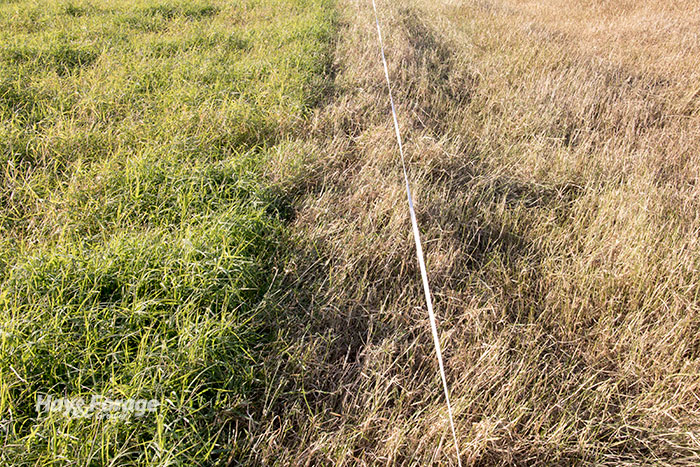Do this with stockpiled grass |
| By Mike Rankin, Managing Editor |
|
|
 At this point in the growing season, stockpiled grass should be looking pretty good if adequate moisture has been received. Don’t waste it! Although opening the gate and leaving the cattle to their own devices will provide late-season grazing value, there will also be a lot of waste involved, and the number of available grazing days will be significantly reduced. Fortunately, there is an alternative — strip grazing. “Strip grazing stockpiled forages, using temporary electric fence, can offer the highest utilization of the pasture,” notes John Jennings, University of Arkansas Extension forage specialist. “In Arkansas demonstrations, strip grazing management doubled the number of animal-unit grazing days per acre compared to continuous grazing of the entire stockpiled pasture.” Strip grazing entails stretching a single strand of electric polywire across the field to allow the cattle access to a small strip of the stockpiled forage, portioning enough for a one- to three-day grazing allotment. After cattle graze each strip of forage, the wire is advanced across the field to provide fresh strips of forage. “Some producers have found that two wires work better for strip grazing,” Jennings explains. “One wire limits the cattle to the strip being grazed, and the other wire is placed one strip ahead to prevent the cattle from moving across the entire field each time a new strip is offered. Only one wire needs to be moved each time in an alternating pattern to provide a fresh strip of forage.” Begin grazing on the end of the field nearest the water source. This reduces trampling damage to the remaining forage because the cattle travel back across the grazed area for water. A back wire is not needed when grazing dormant stockpiled forages, so the cows’ resting area becomes larger as each strip is grazed. “For pastures with the water source near the middle of the pasture, simply strip graze each side of the pasture starting at the water source,” Jenkins suggests. “Place a second fence wire to restrict access to the half of the pasture that is not being grazed until grazing of the first half is finished.” Determine the correct strip size The key to successful strip grazing of stockpiled forage is to determine the correct strip size. Generally, the width of the field is fixed, so it becomes a matter of how many feet of length to allot with each move. For this, you’ll need to know three things: 1. The daily forage dry matter intake of the livestock being grazed 2. An estimate of available forage yield per acre 3. The width of the pasture To figure the appropriate strip length, Jenkins provides this equation: (Number of head x average weight x forage intake as % BW x number of days per strip x 43,560) divided by: (Forage height x pounds of forage/inch of height x % grazing utilization x field width) Here are a few things to consider as you fill in the equation blanks: 1. Forage intake as a percent of body weight varies with livestock class. Use these values as starting points: nonlactating dry cows, 2%; lactating beef cows, 2.5%; and stocker calves, 3%. 2. To determine the pounds of forage per acre per inch of height, an average for bermudagrass is 260 pounds and for tall fescue, 210 pounds. Thin, unmanaged stands can be up to 100 pounds per acre less. Well-managed, fertilized stands can be 150 to 200 pounds per acre more per inch of height. 3. Even with top management, cows won’t eat everything. If moving cattle twice per week or more, forage utilization will be about 70%. For example, if the total yield is 3,000 pounds per acre, the amount of available forage will actually be 2,100 pounds. Jenkins says that this approach should get you close to the correct size, but he notes that adjustments may be needed based on actual grazing results. Simply make the strip a little larger or smaller based your observations. |
